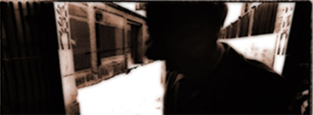Is it a mortal sin to stagnate?
Is it a mortal sin to stagnate?
Despite being three separate enterprises, the exhibitions on Martin Kippenberger, George Widener and Robert Rauschenberg at Hamburger Bahnhof turn out to be related on some levels.
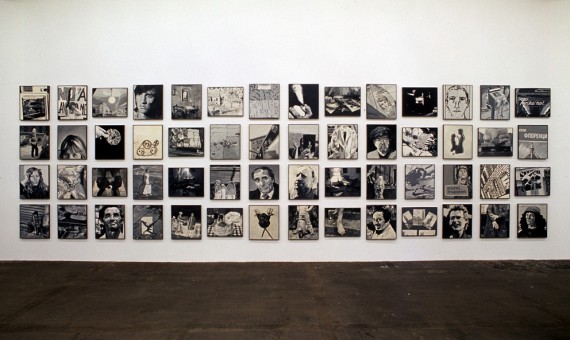
Besides the permanent collection and the main exhibition showing the German artist Martin Honert (b. 1953), which runs until the 7th of April, Hamburger Bahnhof’s are also showing one large and two smaller separate exhibitions this spring. These exhibitions, despite their seemingly unrelated works and artists – one German and two Americans – bring together thoughts investigating life’s various concepts through twisted logic and based on ‘bad painting’: pictures of pictures and art tourism.
Already during our years of study at art academies, we are told to differentiate between and realise the importance of the worn out, yet constantly alternating concepts form and content. For some artists, form is the essence of a piece – where the work becomes capable of articulating anything interesting and true concerning mankind and the times and community the artist acts within. As a consequence, the material becomes simply a means, in some cases even irrelevant. For other artists, the distinctive characteristics of a material may function as a key to the inherent meaning and the eventual, forceful impact of the work. Still others may feel that form constitutes an important function of the material, important to the piece as a whole. In this case, any function or character provided by the form is rather automatic; it goes without saying and stands in the shadow of the material itself.
This pair of concepts illustrates transparency, in the days when transparency – transparency that paradoxically rose out of defiant will and a strong wish to cross borders – could be defined as dependant on the situation, the context, in which the work appeared. In that situation, neither form nor material is essential, only the process itself and its effects.
These three artists all deal with the artistic process; art doesn’t end where life begins, nor the other way around. Art is an on-going process, most often with considerable personal capital invested. I am reminded of Camus and his words about being faithful to both beauty and the rejected, and find that device valid for the art and life of these three artists.
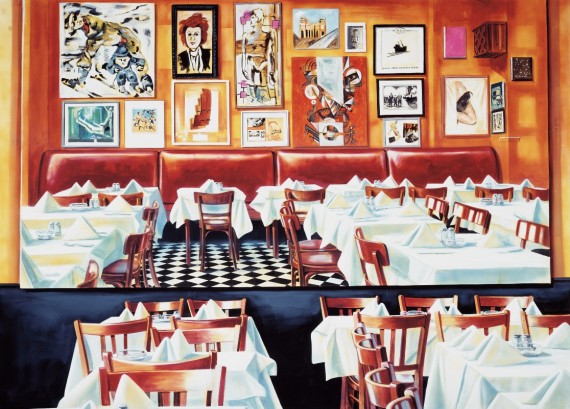
A human wreck
Martin Kippenberger (1953–1997) was an unassuming character who died as a result of severe liver damage. A destructive relationship with alcohol and a constant stream of demanding projects wore his body out, and cancer claimed him in a hospital in Vienna, at the age of 44. In retrospect – regardless of the fact that the programme book states that this exhibition ‘does not intend to be a retrospective, but rather an approximation of both the private and public persona of the artist’, which I will comment on later – we can fairly quickly grasp that his life was short and fraught but extremely productive. Thousands of drawings on hotel stationary and bar bills, manic, figurative paintings, ironic sculptures, publically commissioned installations, surrealist video art, insignificant slides with tourist motives, posters, books, etc.; all point to a manic, tireless flow of energy. Pictures of pictures would constantly cross his path and incidentally record the gradual decay of his body.
Anything that was out of place, broke the rules, or disrupted convention pleased Kippenberger. Seldom has an artist fought so intensely against and simultaneously ignored the establishment and the conventional ideas of form and language. He was at odds with the unofficial genre guidelines and revolted against the prevailing views on aesthetics and composition. In Kippenberger’s work and life, you could look forever for coherent chains of events or solid boundaries between the inner and outer, but fail desperately due to the lack of a consistent frame of mind. The only reliable thing about him is that he and everything around him were wrecks – artistic ones as well as human. We are talking about an artist who claimed that all modern art was rubbish and would openly mock other artists, but at the same time renounce his own work. He fought in every thinkable way against the prevailing norms on how art was supposed to be structured. He and his work are void of development and morals; rather, his goal was to dissolve the boundaries between all ideological and aesthetic functions. That is, in some senses, an art. For Kippenberger, the only possible way out of a meaningless, enveloping reality was to create art that was even more meaningless, dumb, obvious and superficial.
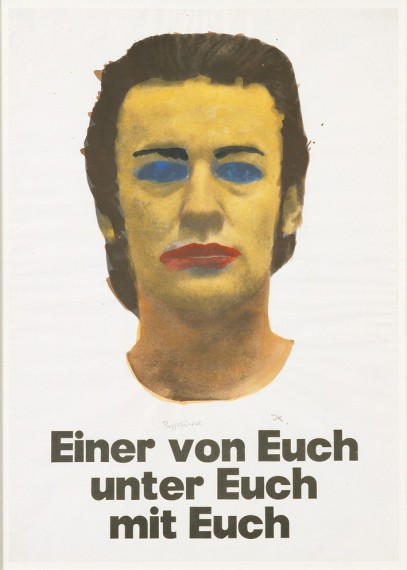 His legacy could be regarded as one gigantic exercise in self-effacement, without any kind of subsequent analysis or reflection. His work is never perspicacious or sophisticated, there are no philosophical interpretations. In fact, it feels rather stuck-up and arrogant; there are loads of platitudes and nonsense. Reminiscent of pop art, Kippenberger assented to the superficial, and I think that he would easily agree with Warhol’s famous statement, where he claimed that you should regard both him and his work as superficial. He was surface personified; there was nothing beneath. This is both true and false, as the experience is – as I’ve mentioned before – dependent on its context; art turns into what we, as viewers, choose to put in it. Kippenberger’s ideas pushed him further: ‘I am travelling salesman, I deal in ideas’. And even if these ideas not always were his own, he always managed to put himself at the centre; in different figures and characters, always playing a part, based on accurately formed as well as improvised scripts and situations.
His legacy could be regarded as one gigantic exercise in self-effacement, without any kind of subsequent analysis or reflection. His work is never perspicacious or sophisticated, there are no philosophical interpretations. In fact, it feels rather stuck-up and arrogant; there are loads of platitudes and nonsense. Reminiscent of pop art, Kippenberger assented to the superficial, and I think that he would easily agree with Warhol’s famous statement, where he claimed that you should regard both him and his work as superficial. He was surface personified; there was nothing beneath. This is both true and false, as the experience is – as I’ve mentioned before – dependent on its context; art turns into what we, as viewers, choose to put in it. Kippenberger’s ideas pushed him further: ‘I am travelling salesman, I deal in ideas’. And even if these ideas not always were his own, he always managed to put himself at the centre; in different figures and characters, always playing a part, based on accurately formed as well as improvised scripts and situations.
An exhibition failing to represent the wreck
I see two main problems with this exhibition. The first is that the creators have failed to incorporate his larger performative, and in some senses political, installations from the last ten years before he died, either physically or through still or moving pictures. One example of these would be his full-scale subway entrances, which he placed in absurd settings, like the Swiss Alps or on the island of Syros in Greece. Another is his purchase of an ordinary, functioning petrol station in Brazil, under the fictitious name of Martin Bormann, in which he even gave daily instructions to the staff, which he just met once. When he was accused of neo-Nazi attitudes as a result of this shortly thereafter, he created several full-scale sculptures of himself, placed in corners facing the wall, which he entitled ‘Martin, Go Stand in the Corner, You Should Be Ashamed of Yourself’. This one though, is a part of this exhibition, but otherwise his installations are conspicuously absent.
However, my strongest objection concerns the curator’s misconception. If you were given the task of staging a decadent and destructive oeuvre – the completely tattered life of an enfant terrible, a revolutionary clown of the art scene, who wanted to tear down the walls from the inside and in every possible way reiterate the perishability of life and art – then why show his work like any ordinary exhibition, in neat rows on flawless white walls? When I see the quotation ‘Berlin must be repainted’ on the wall in a fancy font, it feels like an insult to both Kippenberger and us. Why not transform the showroom into a gigantic bar? Where we could honour him by spilling our drinks and putting out our fags close to his remains? Or find another location. Possibly several locations. Places that would link his art with his life. Nevertheless, I bought a monograph on my way out, since the book seems to be where I might find that ‘approximation of both the private and public persona’, which this exhibition falsely claims to be showing, but unfortunately, never even comes close to.
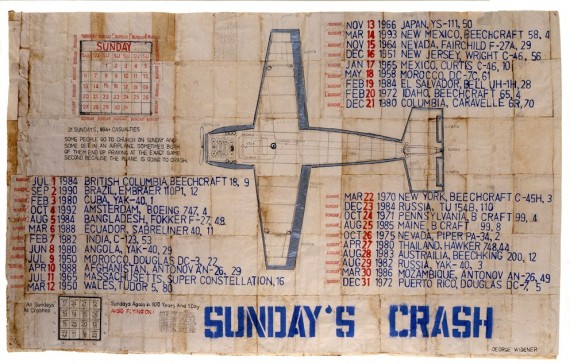
Pictures of a diagnosis
George Widener was born into a poor Appalachian family in Kentucky, USA, in 1962. Owing to the social circumstances and a lack of awareness about autism in the area, he went through a great deal of suffering during his childhood. It wasn’t until adulthood that he received the diagnosis Asperger’s disorder. The very talented but misunderstood and bullied character spent most of his youth in local libraries reading, drawing, and gathering information. As a result of this involuntary alienation, Widener developed a profound interest in numbers, dates, historical data, statistics, and mathematic calculations. Today, he combines historical events or conceivable futuristic scenarios with his own calculations on loosely jointed sheets of paper. The results consist either of magic squares (smaller squares within one large, where the smaller ones are filled with numbers so that every column, row or diagonal creates equal sums) or pictures of fictitious, futuristic urban environments, cluttered with series of numbers and dates.
The interesting aspect of Widener is neither his diagnosis nor its consequences, but rather, his work. Certainly, one might sink into the aura of mysticism that his extremely detailed sheets seems to emit, and yes, maybe even the methodical detective within us comes alive and wants to solve the riddle. Of course, some of the exhibited sheets are also beautiful little fragments, resembling hieroglyphs or antique maps. But no, what really matters here are the questions his work raises about authenticity and subjectivity in art. His works present a desirable truth; the art is ‘for real’. He presents and solves problems, he questions conventional ideas on material, content, and aesthetics by ignoring them. There are no art traditions standing in his way, nothing he must choose or reject, no right or wrong – he is a true autodidact! In general, you might claim that art depends on the subject, but opinions differ over whether art depends on the emotional depth of the subject. Some people express the extreme that the subject must be erased in order to uncover a higher existence. In Widener’s case, we have the opposite: in his own comments and writings, in documentaries about him, in the museum leaflets and in newspaper reviews, it is without exception his diagnosis – that of the prodigious savant – that receives focus, not his work. And while we cannot argue against his condition, his art must be questioned – private premises can be a jumping-off point but never an intellectual foundation.
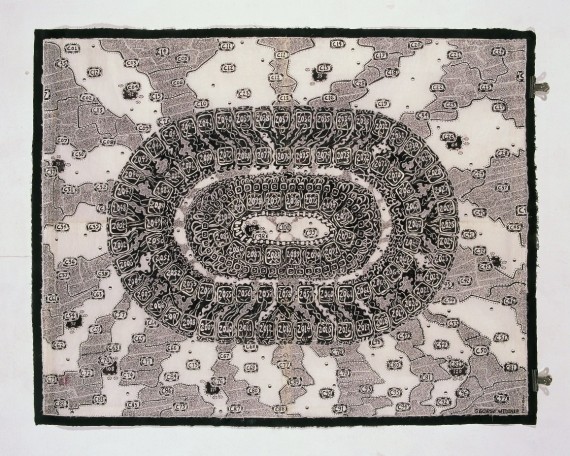
Technological theatre out of focus
One of the museum wings houses pop art. Besides some of Warhol’s portraits, one can also see works by Johns, Twombly, Liechtenstein, and Robert Rauschenberg (1925-2008). In 9 Evenings: Theatre & Engineering, Rauschenberg has been given extended attention until June this year, as he was one of the originators of this now classic event, which took place nine evenings in a row in October 1966. This pioneering project within contemporary experimental stage art saw a New York based community of artists, among them John Cage and Merce Cunningham, working in close cooperation with a large number of engineers with the overarching goal of investigating technology’s potential in art.
The artists and engineers were filmed together with a – in those days – unparalleled amount of ambulating visitors, since this event was so innovative. The documentation should therefore be regarded as equally important as the event itself, considering its historical and pedagogic value. This is especially true for today’s performing artists, who seek to extend their understanding of the history of cross-disciplinary stage art. Considering these unique conditions for a rare visual experience of an almost fifty year old performance, an art media work of colossal value, even in our days, I was utterly disappointed to find that the quality of both picture and sound are disastrous. The cameramen are either constantly high on something or have put a piece of plastic in front of their lenses or both. It is almost impossible to understand the different actions on stage through this coarse visual fog. As if this debacle wasn’t enough, the curator has decided to show only one looped fifteen minute segment per month!? I don’t understand. If you get your hands on valuable historical film material – regardless of quality – that stretches over a number of hours, why not let it roll non-stop during exhibition hours, in this case eight hours per day (except Mondays), for the duration of the display? If I, as a visitor in Hamburger Bahnhof, feel an urge to see more than fifteen minutes, I have to wait until next month!
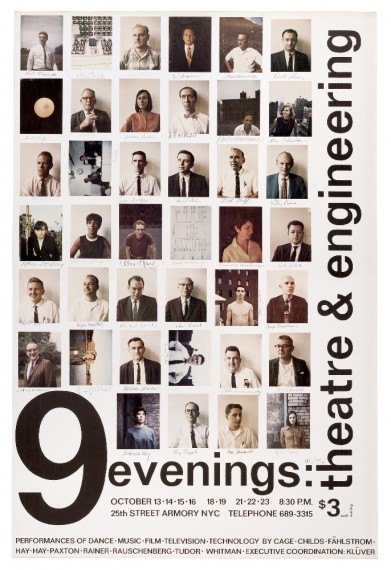
A self-generating perpetual motion machine
I am left standing outside the film room with the superficiality of the pop art all around me. I am reminded that the key phrase for the aesthetic activities during the 60s – exceeding borders – still resonates between high and low, between different media and forms of expression, between artist and observer, between artwork and its social context, between art and politics. While the pop art rejected the multi-layered subjectivity that the expressionists were striving for, Kippenberger turned his back to all of them. When other artists pointed out the importance of being able to separate good from bad, he stopped bothering. For him, art became a declining perpetuum mobile, kept in motion by the constant lack of consistency between the statements being made and the actual story being told. He was, in several senses, living in a flowing reality; filled with alcohol and impatience, he had no time to wait in a constant state of abstinence. There were no days to count; every day was there to present him with more satisfaction then the day before.
Kippenberger regarded his pieces as artefacts: severed objects without any deeper meanings or coherence. He didn’t believe in the potential of art, but he didn’t believe in anything other than art, either. But regardless of your opinion of his art, it is not hard see him and his work as an example of the creation of power and of ideas. But why did he try so hard to create when he simultaneously saw himself and his surroundings as one major, meaningless wreck? Probably because the opposite – stagnation, insignificance, death – was even worse. And despite the variations that come from an individual’s circumstances, processes and aesthetics, one could claim that Kippenberger, Widener and Rauschenberg unite in this last thought and moreover in the central theme. They deal with the idea of life and art as two inseparable metrics and the fact that there is only one mortal sin for both: to remain standing in the same place. To stagnate.
MARTIN KIPPENBERGER
Sehr gut/Very good
23rd February – 18th August 2013
GEORGE WIDENER
Secret Universe IV
25th January – 16th June 2013
ROBERT RAUSCHENBERG
9 evenings: Theatre & Engineering
Monthly screenings of the film until 30th June 2013
Hamburger Bahnhof, Berlin

